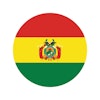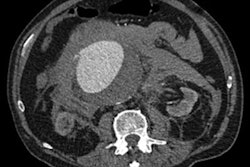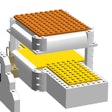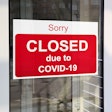
The first details about the long-awaited white paper on teleradiology from the European Society of Radiology (ESR) will be revealed on Friday, 11 October, at the Management in Radiology (MIR) congress in Barcelona, Spain.
At its heart, the paper has some robust messages designed to facilitate the implementation of teleradiology within the infrastructure of existing healthcare systems. Interaction with local healthcare professionals and smooth integration with existing protocols are top priorities, and patient care should drive standards, according to Dr. Erik Ranschaert, who co-authored the paper as chair of the ESR task force on teleradiology.
 The teleradiologist should be known to local staff and he or she should be able to consult with them, according to Dr. Erik Ranschaert.
The teleradiologist should be known to local staff and he or she should be able to consult with them, according to Dr. Erik Ranschaert.
"The patient should never be the victim of teleradiology," stressed Ranschaert, a staff radiologist at Jeroen Bosch Ziekenhuis, 's-Hertogenbosch, the Netherlands. "The quality should at least be as good as the service delivered by local radiologists, with teleradiology considered an integrated medical service, not just a technique."
The white paper is due to be issued by the ESR later next month, to coincide with the Radiological Society of North America (RSNA) conference. Some specific items related to the white paper are still under discussion, and the document needs formal approval by the Executive Council of the ESR.
In writing the paper, Ranschaert was joined by other experts from across Europe, each with particular expert knowledge that qualified them to write a dedicated chapter. The contents table reflects issues such as legal aspects, security, regulatory issues, patient safety, communication, technical issues, and quality assessment.
Indeed, the changes currently being seen in teleradiology make it a prime time for a white paper that amalgamates all the various topical issues into one document, and it will be both readable and easily accessible for the busy, practicing radiologist, according to Ranschaert. He is due to give the first presentation on the new white paper at the MIR congress on Friday morning.
Essentially, the document discusses the importance of both teleradiology and teleradiologists being made an integral part of the whole decision-making and communication process within a local hospital, thereby being reliably informed of local procedures and practices. Communication is a priority topic, and the chapter discusses how teleradiologists should communicate openly with local physicians, referring physicians, and radiographers, for example, in discussion over which protocol to use for which particular examination.
"The teleradiologist should be known to local staff and he or she should be able to consult with them. Also, there should be effective working structures in place to facilitate communication," he said, adding that services provided by teleradiology should never be inferior in quality to the care delivered by local radiologists.
Cross-European teleradiology
The rapid evolution of the field, underpinned by the mounting wave of digitization occurring across parts of Europe, makes the paper very timely, according to Ranschaert. The Nordic countries (Scandinavia and Baltic states), Benelux, Germany, Spain, and the U.K. have already fully embraced PACS technology, implementing it widely, but in some nations there is a degree of hesitation to use cross-border teleradiology, despite it being well-suited to international situations by its very nature. To an extent, the white paper should help address some of the reservations in this area, he commented.
 Dr. Osman Ratib, head of the ESR's eHealth and Informatics Subcommittee, has supported the teleradiology initiative.
Dr. Osman Ratib, head of the ESR's eHealth and Informatics Subcommittee, has supported the teleradiology initiative.
Teleradiology alongside telemedicine is high on the agenda of the EU, also making the paper timely. Politically, there is a strong belief that using teleradiology and telemedicine will facilitate provision of medical care efficiently at reduced cost, and this will increase access to healthcare for patients, he explained.
Another issue addressed in the white paper is that of the extensive variation in guidance available to radiologists across the EU.
"Responsibility for providing and organizing healthcare remains with each individual EU member state, but each state has different legislation or guidelines that are often sourced from national societies," Ranschaert pointed out. "However, many member states lack such guidance, so the ESR wants to address this by offering all radiologists guidelines upon which they can base their local guidelines."
The original idea for the white paper came from the ESR's eHealth and Informatics Subcommittee, of which Dr. Osman Ratib, a professor and the chair of the department of medical imaging and information sciences at University Hospitals of Geneva in Switzerland, is currently the chair.
Electronic version of white paper
Intuitively, an electronic document as opposed to a static paper is the obvious answer to making an up-to-date resource available to the radiology community, especially in such a fast-moving field. In fact, the white paper began as an electronic document, effectively a living document, easily updateable and accessible on Google Drive, an electronic file available wherever there is an Internet connection. The e-document also contains all relevant reference material, readily available. At the moment, the electronic version is only available to contributors, but eventually it will be accessible to other radiologists too.
"From the outset, I wanted this white paper in a digital, collaborative form, so we started working on Google Drive. We created an online document, published the table of contents, and asked contributors to post their chapters on Google Drive," Ranschaert noted.
Training aspects
In recognition of the growing importance of teleradiology, the ESR stresses the importance of providing training in telemedicine and teleradiology, and it envisages workshops and training sessions in the near future. These are likely to be organized in the ESR learning center in Barcelona.
The ESR also advises radiologists in the EU to take the European Diploma in Radiology (EDiR) examination, which is an objective test of knowledge and skills for radiologists at the end of training as specified in the European Training Curriculum for Radiology. This is aimed at standardizing and harmonizing the quality level of radiology throughout the EU, and is important to enable and facilitate cross-border teleradiology (www.myebr.org).
Standards and guidelines
Ranschaert also emphasized the importance of understanding the degree of risk involved in certain aspects of teleradiology, which is why he and his colleagues on the white paper task force want to publish quality standards and guidelines for contracting and financing teleradiology services.
"This is useable information that is not only relevant to radiologists, but hospital managers too," he said.
Reflecting on the future of teleradiology worldwide, which is one of the core drivers behind the report, he said the whole radiology arena is changing, with increasing competition from outside of the hospital, both on the European and U.S. scene. Service providers will face more competition and need to provide greater specialty or subspecialty knowledge applicable to local requirements, and at a more competitive price.
"Indeed, the EU is less affected than the U.S., but this scenario might play out in Europe in years to come. The ESR is trying to make radiologists aware of this and to stimulate them to remain involved and aware," he said.
Provided it is accepted, the ESR white paper is due to be published in the December edition of Insights into Imaging to coincide with the RSNA meeting. The electronic version will be available at a later date.



















